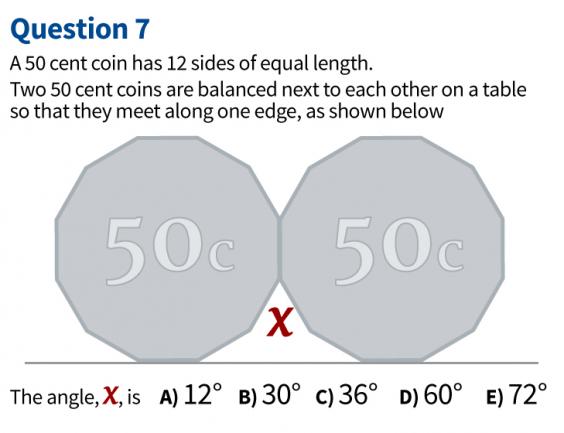
The question given to Year 12 Further Mathematics students in their Victorian Certificate of Education (VCE) exam in Australia, asked for the degree of an angle between two 12-side coins.
"A 50 cent coin has 12 sides of equal length. Two 50 cent coins are balanced next to each other on a table so they meet along one edge," the question reads.
Students were asked to find the degree of x in the middle, giving them options ranking from 12 degrees to 72 degrees.
Unable to figure out the answer, some students shared their confusion on social media, hoping to find help in solving the problem.
Scientific exchange: Advances in math discussed
One student frustratingly posted on Facebook, “That exam wasn't there to test us, it was to trick, no one could have prepared for that.”
Another claimed, “The 50 cent coin question makes no sense to me as it asked us to find the angle, but it gave us no other angles or lengths to enter in the formulas so there was simply no way about it.”
However, some people, baffled by the confusion of these students over the ‘easy question’, took to Twitter to share their opinion.
Well, as a Maths Methods, not a Further Maths student this was a cinch, but I get why people are getting stumped https://t.co/SQIcQDAtin
— Angela (@Angelayang) November 2, 2015
Are kids really this stupid these days? https://t.co/Z1PNDkzqK5
— Ed Trinh (@ed_trinh) November 2, 2015
https://twitter.com/JamColley/status/661121411742720000?ref_src=twsrc%5Etfw
According to local news site, The Age, teacher Graeme Newman described the question as ‘challenging’, but ‘fair’. He told the site, “Most exam questions try to give students a bit of a ‘kick along’ in terms of the way they set up the diagrams. They didn't do that in this question, they really needed to draw the triangles themselves and work it out from there.”
How to work out the answer:
The answer to the question is 60 degrees. There are different ways to come to the correct solution. Here is one of them:
1) Calculate the sum of the interior angles of the coin. The formula for this is (Number of sides x 180) – 360, so the sum of the interior angles of the 12-sided coin is (12x180)-360=1800.
2) The coin is a regular 12-sided polygon, so all its internal angles are equal. To find the value of one internal angle, divide the sum of interior angles by the number of sides, so 1800/12=150.
3) A full circle is divided into 360 degrees. In the question the angle θ comprises part of a circle along with one internal angle from each of the coins. As one internal angle is 150 degrees, the two adjacent angles add up to 300 degrees, leaving θ with a value of 360-300=60 degrees.
This article originally appeared on Independent.

1732274008-0/Ariana-Grande-and-Kristin-Chenoweth-(1)1732274008-0-165x106.webp)



1732273396-0/Copy-of-Untitled-(72)1732273396-0-270x192.webp)
1732269802-0/Copy-of-Untitled-(71)1732269802-0-270x192.webp)
1732261957-1/Copy-of-Untitled-(66)1732261957-1-270x192.webp)


1732258132-0/BeFunk_§_]__-(26)1732258132-0.jpg)






COMMENTS (14)
Comments are moderated and generally will be posted if they are on-topic and not abusive.
For more information, please see our Comments FAQ